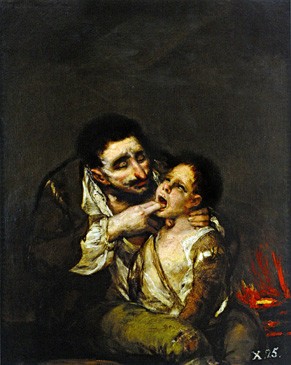- Cronología
- Ca. 1808 - 1810
- Ubicación
- Private collection, Madrid, Spain
- Dimensiones
- 80 x 65 cm
- Técnica y soporte
- Oil on canvas
- Reconocimiento de la autoría de Goya
- Documented work
- Titular
- Private collection
- Ficha: realización/revisión
- 21 Apr 2010 / 15 Jun 2023
- Otros títulos:
-
Diphtheria (Curación del garrotillo)
X 25 (lower right-hand corner).
During the Spanish War of Independence, Goya produced some private works including this one, Majas on a Balcony, Maja and Celestina, and probably Time or The Old Women.
The work was inherited by Javier Goya when his mother died, according to the inventory of 1812 ("El lazarillo de Tormes, n.º twenty-five valued at 100 [reales]") and the inscription "X" for Xavier followed by the number which appears on the canvas. Baron Taylor bought the piece in 1836 for the King of France, Louis-Philippe I of Orleans. It was placed in the Spanish Gallery (Galerie Espagnole), leaving France when the king was dethroned. The painting was then sold at Christie's of London in 1853 for the price of 11.10 pounds (lot nº 171). It was later purchased by the Duke of Montpensier, son of Louis-Philippe I, who was married to the Infant Luisa Fernanda, Isabel II's sister, and left to the family lawyer, Caumartin. It was registered as being in his possession until 1867. In 1902 it was located in the Maugeau collection. The canvas was sold in Bordeaux in 1923 to the Marquis of Amurrio, who then left it to Doctor Gregorio Marañón. It was later inherited by its current owners.
This work had traditionally been identified by the title Diphtheria (La Curación del garrotillo), since this disease at the time was thought to be cured by cauterizing the throat. However, the mention of the 16th-century picaresque novel by an anonymous author in the inventory of Goya's possessions corrected this interpretation of the subject.
The painting depicts a dark, interior scene, lit by the flames of a fire, featuring a dishevelled man and half-naked boy with his clothes in tatters. The man, his eyes closed, grips the boy between his legs and supports his head firmly with his hand while he puts his fingers down the boy's throat. The boy expresses his pain and the discomfort of the situation in his eyes, gazing upwards. The image represents the scene in the novel in which the villainous blind man's guide has substituted the longaniza sausage which the blind man had given him to cook with for a turnip, and is being smelled by his cruel master to prove whether he has eaten it.
The characters are represented realistically, and their shabby clothing is depicted in great detail. However, the subject is also suited to the inclusion of a measure of comedy and irony, and accordingly the figures are somewhat caricatured. The setting for the scene does not require any details to make the action intelligible, and for this reason Goya has only included the fire and a line or two which suggest depth.
-
Notice des tableaux de la Galerie Espagnole exposés dans les salles du Musée Royal au LouvreGalerie Louise PhilippeParís18381838cat. 102
-
GoyaMinistry of Foreing AffairsBurdeos1951organized by the Bordeaux City Hall, consultant editor Gilberte Martin-Méry. From May 16th to June 30th 1951cat. 50
-
GoyaPrado National MuseumMadrid1951July 1951cat. 23
-
Goya. Gemälde Zeichnungen. Graphik. TapisserienKunsthalle BaselBasle1953from January 23th to April 12th 1953cat.35
-
GoyaFestival Internacional de Granada, Palacio de Carlos VGranada1955consultant editor Enrique Lafuente Ferraricat. 117
-
Francisco de Goya. IV Centenario de la capitalidadorganized by Ayuntamiento de Madrid and Dirección General de Bellas Artes at the Casón del Buen RetiroMadrid1961consultant editor Valentín de Sambriciocat. LIX
-
cat. 87
-
Goya and his timesThe Royal Academy of ArtsLondon1963cat. 66cat. 80
-
La Galerie Espagnole de Louise PhilippeMusée du LouvreParís1981cat. 106
-
De Greco á Picasso. Cinq siècles d’art espagnolMusée du Petit PalaisParís1987from October 10th 1987 to January 3th 1988cat. 106
-
GoyaNationalmuseumStockholm1994consultant editors Juan J. Luna and Görel Cavalli-Björkman. From October 7th 1994 to January 8th 1995cat. 38
-
Goya en las colecciones españolasSala de Exposiciones del BBVAMadrid1995consultant editor Juan J. Luna. From December 14th 1995 to February 17th 1996cat. 106
-
Goya: Prophet der ModerneAlte NationalgalerieBerlin2005from July 13th to October 3th 2005. Exhibitied also at the Kunsthistorischemuseum, Vienna, October 18th 2005 to January 8th 2006, consultant editor Manuela B. Mena Marquéscat. 99
-
Goya en tiempos de guerraMuseo Nacional del PradoMadrid2008consultant editor Manuela B. Mena Marqués, from April 14th to July 13th 2008cat. 38
-
GoyaParísMinistère d’Etat-Affaires culturelles y Réunion des Musées Nationaux1970vol. I, p. 352, cat. 585
-
Vie et ouvre de Francisco de GoyaParísOffice du livre1970pp. 256, 266, cat. 957
-
L’opera pittorica completa di GoyaMilanRizzoli1974p. 122, cat. 484
-
Francisco de Goya, 4 vols.ZaragozaCaja de Ahorros de Zaragoza, Aragón y Rioja1980-1982vol. III, p. 191
-
Goya en tiempos de guerraMadridMuseo Nacional del Prado2008p. 254, cat. 66 y p. 255 (il.)
